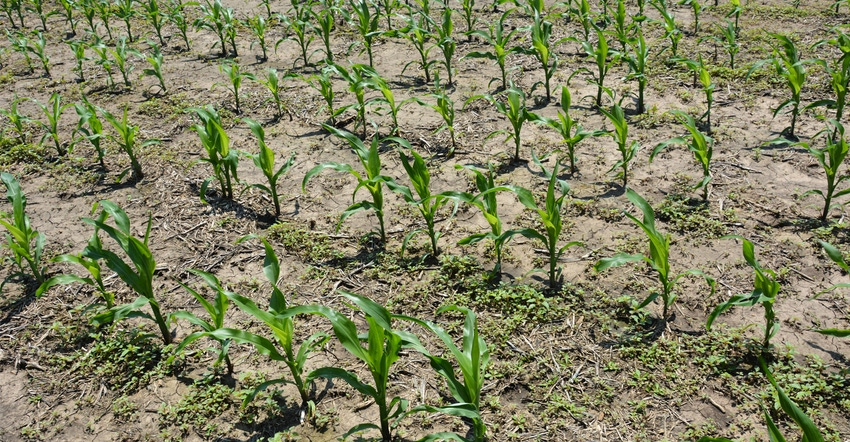
When it comes to corn planting numbers, Kansas is in better shape than many of its neighbors.
While the unplanted corn acres estimated in the May 20 National Agricultural Statistics report stands at a record 39 million, Kansas growers have been able to get seed in the ground for an estimated 70% of the 5.7 million acres of corn they planned to plant.
While that is still down about 20% from last year, it is far better than the average of the top 18 corn-growing states, which stands at only 58% of intended acres, compared to an average of 90% over the last five years.
Some of those Kansas acres are now standing underwater in bottomlands along rivers and streams. Just how bad flooding will get before rivers recede is still unknown, as the weather forecast has called for another round of almost-daily showers the first week of June. More than 40 rivers and streams in southern Kansas were in flood at the end of May, with the worst conditions on the Arkansas and the Neosho.
On May 30, Paul Penner, who farms in Marion and Dickinson counties, offered to guide a tour of some of corn and wheat fields in the region. Almost no soybeans had been planted by the end of May as farmers used whatever time available to get corn planted as time for that crop ran out. Soybeans, sorghum and cotton can be planted much later than corn.
“I have gone as late as July 10 to put in beans,” he said. “You are getting more of a double-crop result with that but it’s doable. And I plan to double-crop every acre I can even if wheat harvest is late.”
Penner has about 500 acres of corn planted on his own land and more on land he custom farms for other landowners. All of it is on upland fields, and he has no fields that are flooded. There is evidence of water damage in several other fields, though, especially conventionally tilled fields.
Of greater concern to him, he said, is weed pressure. With two solid weeks of almost daily rain, some of it heavy rain, weeds are coming on strong. Penner said at least 400 acres of his corn needed to be sprayed to control weeds before they get too big to be killed.
The weather forecast gave him about two days to get that done before the next round of rain. Fields were mostly still too soft to attempt getting a sprayer in on May 30, although they were firming up fast under sunny skies and brisk wind.
“I’m going to have to wait for winds to die down a bit, but the forecast says it will this afternoon. I have a couple of fields I think I can get into by then,” he said. “I have a couple more fields that I need to get a top-dress of nitrogen on as well, but I have the same problem with being able to get into them.”
As much of farming is, this spring has been a timing game.
“I managed to catch a window of two days right before the rainy period started,” Penner said. “I planted 500 acres in two days, but I made the window. When I planted, it was warm and the first couple of inches of soil were dry. Overall, I’m pretty happy with the stand and the condition.”
Penner said he plants corn 2 to 2 1/2 inches deep to ensure the root system develops deep enough in the soil to keep the plant upright as it grows.
“I’ve seen a lot of fields where I think the farmer planted too shallow and by harvest, the stalks are on the ground,” he said. “One thing I’ve learned is that seed placement really matters in all crops, but especially in corn.”
Wheat harvest looks promising
Wheat fields, by contrast, are looking really good in spite of some signs of leaf and stripe rust.
“In places not prone to standing water, the weather we’ve had has been great for wheat,” Penner said. “Cool with plenty of rain is great for grain fill. It’s looking like a pretty good harvest.”
He said his worst wheat field is the one closest to his home farm, where he had an accidental application of the wrong herbicide.
“I had just a little bit in the bottom of the tank and didn’t realize it,” he said. “When spring green-up came, that field was brown. It’s coming out of it, but it’s short and it’ll likely be the last field I harvest.”
There’s a long way to go to corn harvest, and the weed pressure may turn out to be the greatest problem according to Penner, and there’s no way to know if the rest of the growing season will be favorable.
Around the region, there are scattered spots of wheat with white heads — a sign that it stood in water long enough to kill the plant. There are also numerous fields with evidence of leaf rust, stripe rust and tan spot but not to an extent to cause serious concerns.
About the Author(s)
You May Also Like






